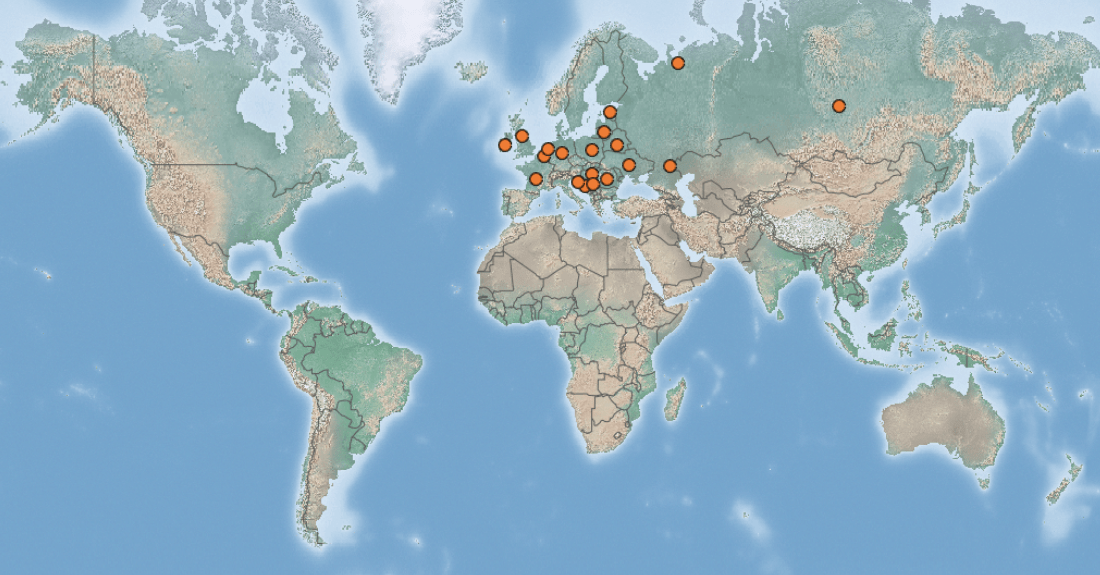 |
Caspian mud shrimp | Status LU: (?). 1st record: 1992. |
 |
Kaspesch Bulliscrevette | Status Eur.: established. |
 |
n/a | RA: ISEIA: B3, Watch List. Harmonia+: n/a. |
 |
Süßwasser-Röhrenkrebs | Wikipedia:     | Wikispecies: n/a (2020) | CABI | Wikispecies: n/a (2020) | CABI |
 |
Kaspische slijkgarnaal | Back to the list of invertebrates |
Contents
Report the species
→ Report Chelicorophium curvispinum to the National Museum of Natural History.
Brief description
Chelicorophium curvispinum (G.O. Sars, 1895) (Syn.: Corophium curvispinum) These small crustaceans construct mud tubes on hard materials and are nocturnal filterers. Densities can be extremely high (over 200,000 individuals per m²). They are often associated with seaweeds. With their lifestyle, the crustaceans can provoke important ecological changes in occupied areas.
See the copyrighted pictures at cabi.org
Status and distribution in Luxembourg
Chelicorophium curvispinum (G.O. Sars, 1895) was first documented by Guy Duhr in August 1992 in the Moselle near Stadtbredimus, municipality of Stadtbredimus (Dhur 1993 cited in Dhur & Massard 1995: 138).
Currently, there are no records of the species in the mdata.mnhn.lu portal (MNHNL, iNaturalist & GBIF 2020).
Risk assessment
ISEIA protocol
B3 (3+1+3+2) = Watch List (Ries et al. 2017: 68).
Harmonia+ protocol
Not assessed yet.
Worldwide distribution
Bibliography
- CABI, 2019. Chelicorophium curvispinum. In: Invasive Species Compendium. Wallingford, UK: CAB International. URL: www.cabi.org/isc [accessed 2020-03-13]
- Duhr, G., 1993. Étude des espèces d’invertébrés immigrés ou introduites dans la Moselle luxembourgeoise et dans les écosystèmes aquatiques qui en dépendent. Historique et répartition actuelle. Centre univ. Luxemb., Dép. Form. pédag., mém. sci. 213 p.
- Dhur, G. & J. A. Massard, 1995. Étude historique et faunistique des Invertébrés immigrés ou introduits dans la Moselle luxembourgeoise et ses affluents. Bull. Soc. Nat. luxemb. 96 : 127-156. [PDF 1896 KB]
- Meisch, C. & J.A. Massard, 2015. Les recherches sur les crustacés (Crustacea) du Luxembourg : aperçu historique. Bull. Soc. Nat. luxemb. 116: 381-390. [PDF 1,22 MB]
- MNHNL, iNaturalist & GBIF, 2020. Chelicorophium curvispinum in MNHNL-mdata, online portal combining species observation from Recorder-Lux, iNaturalist and GBIF. National Museum of Natural History, Luxembourg. URL: https://mdata.mnhn.lu [accessed 2020-03-13]
- Ries, C., A. Arendt, C. Braunert, S. Christian, A. Dohet, A. Frantz, G. Geimer, M. Hellers, J. A. Massard, X. Mestdagh, R. Proess, N. Schneider & M. Pfeiffenschneider, 2017. Environmental impact assessment and black, watch and alert list classification after the ISEIA Protocol of invertebrates in Luxembourg. Bull. Soc. Nat. luxemb. 119: 63-70. [PDF 360 KB]
Suggested citation of this webpage
Ries, C. & M. Pfeiffenschneider (Eds.), 2025. Chelicorophium curvispinum (G.O. Sars, 1895). In: neobiota.lu - Invasive Alien Species in Luxembourg. National Museum of Natural History, Luxembourg. URL: https://neobiota.lu/chelicorophium-curvispinum/ [Accessed 2025-06-30].
Page content last updated on 2020-04-28. Last proofread by Caroline Grounds on 2019-12-05.


